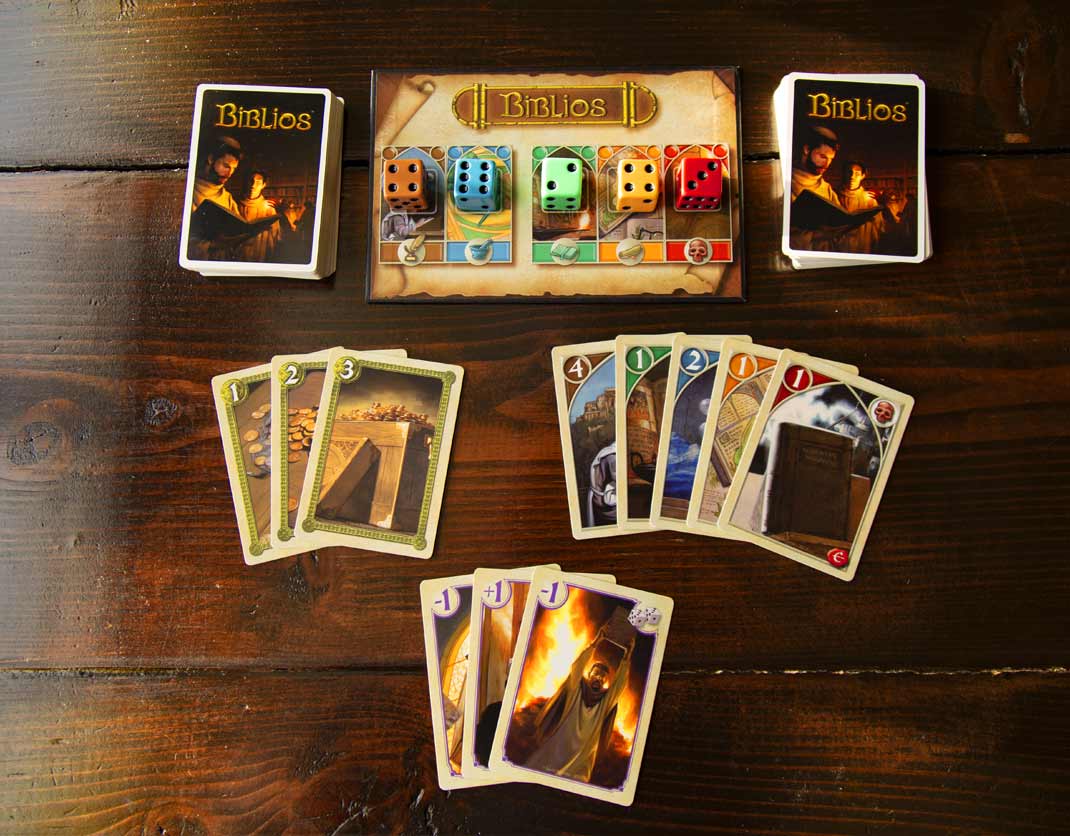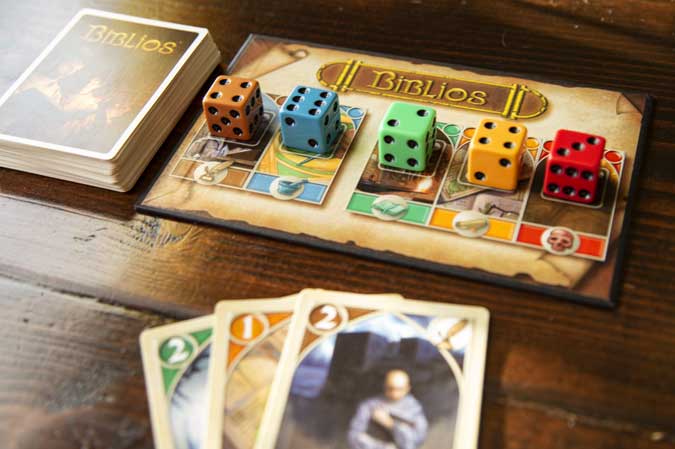Design by Steve Finn | Published by IELLO
In the game Biblios you’re a competing abbot at the head of a monastery working to acquire the greatest book collection of holy books and manuscripts in the midivil world.
Biblios is broken up into 2 phases. The first being a card drafting phase and the second an auction phase. One of my favorite games is For Sale – an auction game of buying and selling real estate. While Biblios is certainly different than For Sale, much of it’s success and failure in my mind will be in comparing it to my love of For Sale.

During the card drafting phase of Biblios players take turns being the active player. The active player is faced with 3 choices: keep a card, place a card up for auction or gift a card to each of the other players. This is done one card at a time equal to one more than the number of players at the table (3 cards in a two player game, 4 cards in a 3 player game, etc.). This can lead to some interesting decisions. You may draft a card into your hand only to realize that a better card sat beneath it in the deck and now you may be forced to place it up for auction later in the game or worse, gift it to one of your opponents. At the end of a players turn, every player will have received one card with one going to the auction pile.


There are three different types of cards in the deck: category cards, gold cards and church cards. The winner of the game is the player that amasses the most ever elusive victory points. Victory points are collected by attaining the highest score in one of the 5 different category cards (pigments, holy books, monks, manuscripts and forbidden tomes). Each category is represented by a single colored die and worth a total of 1-6 points based on the value of that die. This is where the game really gets interesting. Each die starts the game with a value of 3, but can be manipulated by drawing church cards. These church cards allow the player to change the number of the die effecting the end value for that category and ultimately manipulating the card market for everyone going forward.
Along with the category and church cards, there are gold cards that are used to purchase cards later in the auction phase.
Once the entire deck has been drawn the players then move into phase two: the auction phase. During the auction phase players take turns bidding on the cards from the auction deck. Each player may bid with the gold cards they’ve selected (valued at 1, 2 or 3 points each) or with the card value of a category card in their hand. When all cards in the auction deck have either been won or passed on, players count the total points they have in each category and the winner of each category is awarded that categories die. The player with the highest combined dice at the end is declared the winner.
FINAL THOUGHTS
Biblios is essentially two pretty standard games in one. There isn’t anything too special about the drafting phase or auction phase individually. What the game really has going for it is the way players can manipulate the market for category cards by changing the value of the dice as the game goes along. This isn’t always a “take that” approach as some cards allow for increasing the dice value while others only allow you to decrease a value. By helping yourself you may be helping someone else. By devaluing a die – you may be unwittingly plotting your own demise once all things shake out. Of course you’re not required to change any dice when you draw a church card at all. But, these changes to the game can cause you to question your strategy midstream and completely reconfigure your approach keeping you always on your toes. Once the auction phase starts, these changes to the category winners may cause you to end up targeting a completely new category or dumping one all together.

As I mentioned before, I’m a huge fan of For Sale, a classic among gateway-style auction games. For Sale really succeeds in it’s accessibility. It’s so easy to get to the table while being fit for children of all ages. Biblios is fairly accessible and relatively appropriate for children of all ages. Where For Sale separates itself is in it’s theme. In the same hand of For Sale, you may be faced with bidding on a dog house, mansion and space station at the same time. Unfortunately, I’m not quite as glowing when it comes to the theme of Biblios. While the idea of a midivil book fair is fun on the surface, it doesn’t really seem to influence anything in the game and I found myself not even playing attention to the illustrations after awhile (even though that art is pretty decent).

Biblios is a more mature game than For Sale and there is the really cool dice/market manipulation mechanism… but does that give it strong enough legs to supplant For Sale as my go-to auction card game?
I did enjoy Biblios, and as I logged more games, the strategy came more into focus. As with any auction game, your not only playing the game, but playing your opponents as well. The auction phase did seem the weakest as there wasn’t always loads of value left to acquire. My plays always left me with an excess of gold and no where to spend it. I wonder if there is a enough variety in the game to keep that part interesting going forward.
Overall, Biblos is a game I’m going to keep around because it does provide a pleasant distraction from For Sale. The component quality and artwork are solid, it’s easy to get the table and plays in 30 minutes or less. The theme is a bit pasted on, but the game is inspired and one I can see making it to the table ever once and awhile.








